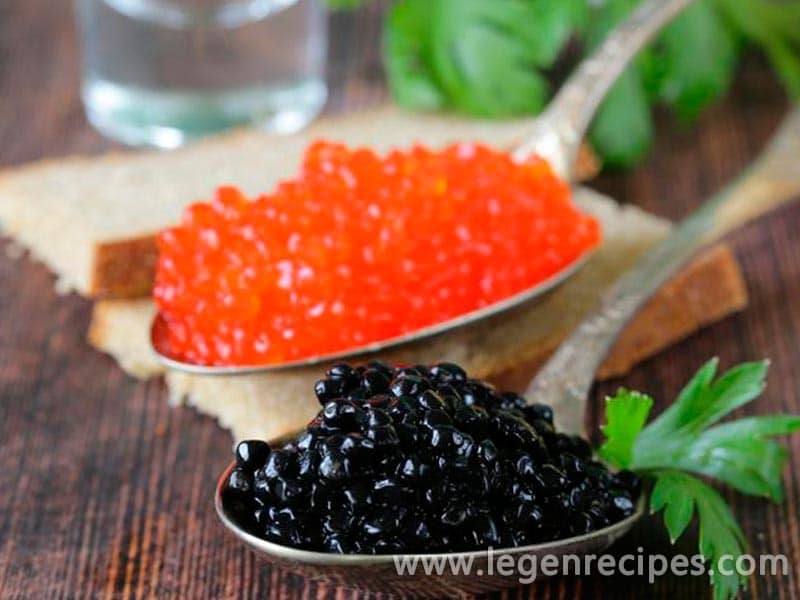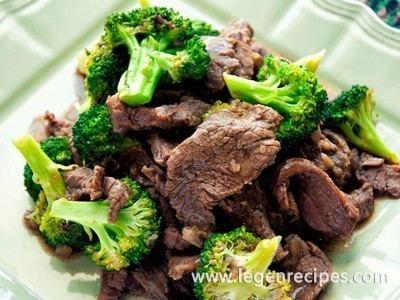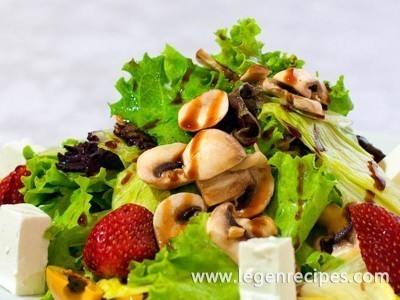Fish caviar in Russia has long been considered a decoration of the table (especially prized black and white). Even in the XIX century, it is not only salted, but cooked in vinegar or “poppy milk” (the so-called squeezed gruel of welded grains poppy), steamed in a clay pot, served in a baked potato, was added to the Lenten pancakes instead of eggs, and with fish – in salty pohlёbku- “Kalju” instead of meat. The famous English navigator James Cook visited in 1778 a Russian settlement on the island of Unalaska, wrote: “I ate cooked Russian whale meat, and eggs, knock like a dry pudding, serve them instead of bread; this bread are very small and they only feed sweetly. ”
Caviar appreciate not only amazing taste, she is also surprisingly useful. It is full of protein – about 30% protein, which is almost completely absorbed by the body (for animal protein is a rarity). In addition, it contains a lot of useful amino acids, minerals, vitamins A, C and D, folic acid. That is why the eggs being prescribed to pregnant women, children and sick people.
Unfortunately, because of the deteriorating year by year Ecology and barbaric acts poachers decimate both salmon and sturgeon caviar is getting smaller. It remains to hope for alternative ways of obtaining eggs – caviar from farms as well as the development of new methods of production of eggs, for example, when the eggs being removed from the fish without killing it. Agree, it’s nice to combine gourmandise with humanity.
The types and grades
In most cases, the eggs are divided into three types.
- Black caviar, which is prepared from sturgeon (beluga, sturgeon, sturgeon), – one of the most delicious and expensive food in the world. Black caviar of different fish varies in taste, color and size.
- Red caviar, which is obtained from fish salmon (chum, sockeye, chinook, coho, salmon, salmon, catfish). The eggs of different fish also differ in taste, color and size.
- White eggs obtained from whitefish, cod and herring fish (carp, carp, perch, pike, roach, pollock, whitefish, herring and others). This is also called the caviar caviar ordinary fish: the name appeared in connection with fishing for certain species of fish so-called “Chastikov” – Part melkoyacheynoy network (as opposed to krupnoyacheynoy that catch sturgeon). We add that the fine-mesh fish are divided into krupnochastikovuyu (pike, perch, catfish, carp) and melkochastikovuyu (carp, sabrefish).
“White Caviar” – often not white, light pink (as lumpfish roe), light yellow (as pollock roe, pike or carp) or orange (like flying fish roe). The unifying characteristic for the white calf is rather its value: it is often rather small, much smaller than red caviar and some black.
Besides flickering light and spawn in some countries decided to tint, for example, tobiko (as in Japan called light orange flying fish roe) and wasabi using ink karatitsy do, respectively, green and black. Similarly, in black and red lumpfish caviar paint.
The most expensive caviar in the world – the “white black”, or rather, the golden sturgeon caviar. First, the older sturgeon or beluga, the lighter the calf. Secondly, white caviar sturgeon spawn rare albino. Price for a jar of “white caviar” obtained from sturgeon or beluga albino albino, Iran and Arab countries could reach several tens of thousands of dollars.
With regard to black caviar, are four types according to its processing method:
- granular caviar immediately after opening the fish raw rubbed through a special sieve (“grohotku”) so that its grain passing through the small holes, cleaned of films and veins.
- Pressed caviar is not as beautiful as grainy, but tastier and longer stored. Immediately after the opening of the fish in the salted roe yastiks (plёnchatyh fish ovaries), and then laid them in a shallow bowl (“splints”) and slightly dried (weather-beaten). Only after that release eggs from the films and crumple tolkushkoy why eggs are denser, turn into a homogenous mass. In taste against the best of the currently available types of black caviar it is just payusnaya Although in Soviet times, it has always been cheaper than grain, which was considered a more “beautiful”, t. E. Had the best appearance, marketability. In fact, pressed caviar is not only the most delicious, but also the most stable in terms of safety.
- Troishnaya considered caviar delicacy in pre-revolutionary Russia, and is now rarely performed. She rubbed through sito- “grohotku” as well as a granular, sharply pour warm strong brine and dried. The name of this caviar your mail got through threes: on them, so as soon as possible, so the eggs were sent from the Volga to the capital – to the luxurious master’s table.
- yastik eggs – the most simple to prepare: it is salted with yastiks (plёnchatymi ovaries fish) and also with yastiks and sell.
Red and white eggs are sold, usually grainy and yastiks.
Sardinian caviar product – botargo. It pressed dried tuna or mullet roe. In form it resembles Milk: 20-centimeter long sausages dark orange color. To prepare botargo used primarily mullet roe, tuna less often, because it is cheaper, Solon. Botargo roe mullet much more delicious than botarga roe of tuna.
In the world known several species of shellfish eggs, including caviar and caviar snails cuttlefish.
We add that there is (in Russian stores actively sold) synthetic or simulated caviar. This surrogate product that simulates the taste and type of fish eggs, most of them – salmon and sturgeon. In view of this caviar is similar to the natural, while it is not sticky; in reality it is elastic balls of gelatin flavored fish (at best) or margarine (at worst). Buy this calf, we absolutely do not recommend: Natural pollock roe costs about the same and outperforms simulated in all respects.
How to cook
In our time, the red, white and black caviar is used in various dishes (usually snacks) so as to best preserve its natural flavor. Accordingly, eggs are rarely exposed to cooking.
However, there are no rules without exceptions. For example, Canadians are made of pike caviar delicious pie: pour over fresh eggs boiling water, cook 10 minutes, rubbed with a fork, mix with raw egg, herbs, bread crumbs and seasoned with salt, pepper, anchovies and lemon juice. The mass is placed in a greased and sprinkled with breadcrumbs form, placed on top of a layer of mashed potatoes with bits of margarine or butter and bake in the oven for half an hour over medium heat.
In Japan, flying fish roe (often tinted) has become an important ingredient for sushi.
The traditional Russian caviar – the main carnival additive to pancakes. In Soviet times, caviar has become the most important product of the New Year’s table (sandwiches with caviar and eggs stuffed with caviar).
Season
From June to October in the north-east of Russia conducted catch chum, pink and sockeye salmon going to spawn in the rivers of Kamchatka and Sakhalin. Sockeye salmon spawning begins one of the first – in late May, allowing us early in the summer to try the first spawn of the new season. Red caviar first grade consists of identical size and color of the eggs is characterized by density, friable, low salt content and a pleasant smell; this caviar they prepare in August and September of this year.
In the area Kaspiysnogo Sea sturgeon comes to spawn twice a year – in spring and summer (May-June) and autumn (August to October). Fish with mature roe goes to spawn a few weeks. If caught in a different time – Eggs get fat if to catch even in the season, but in the sea – shell eggs still tough if caught upstream – shell eggs already inelastic.
Breeding sturgeon farms over time will inevitably supplant sturgeon fishing, as wild sturgeon populations are declining. This process gradually turns black caviar in the off-season product. On the other hand, the product is stored for a long time through the use of preservatives (CHL relatively harmless and Vareks; still controversial preservative used Borax), and it is therefore available in stores all year round.
Add that in Russia there are two holidays, when the eggs on the table is considered almost mandatory. First – Mardi Gras (which falls in February or March), when the eggs to pancakes traditionally served. The second – the New Year: the Soviet times it was a New Year’s table is sure to buy a bottle of red or black caviar.
How to choose and store
In order not to buy a fake, stick to simple rules. Buying eggs in the bank, or weighted, remember, quality eggs, on the one hand, contains no liquid between the eggs, the other – should not be too dry and sticky.
If the quality of caviar weighed easy to determine at a glance, choosing canned beer, it is necessary to know a few tricks. When you turn the jar should be caviar like “move” within if caviar is stationary mass, then it is too dry.
On the lid of the jar with black caviar, there are two sets of figures – the date of manufacture and the number of masters, and banks with red – all the same, plus the word “caviar” in the third row.
Note: if the numbers are printed, or rather pushed through from the outside, but not inside – do not buy it one hundred percent fake.
Another important criterion – the price. 140-gram can of red caviar can cost less than 200 rubles, and 130-gram black Bank – several thousand less.
On the inside of the lid should not be adhering eggs (however, is that you learn only when purchased will open jar).
The eggs must be properly stored: black – at a temperature of -2 … -4º C, and red – at -4 … -6º C. Store the eggs on the coldest shelf of the refrigerator. Very close the jar open and eat the contents of this week: eggs will not survive long.




